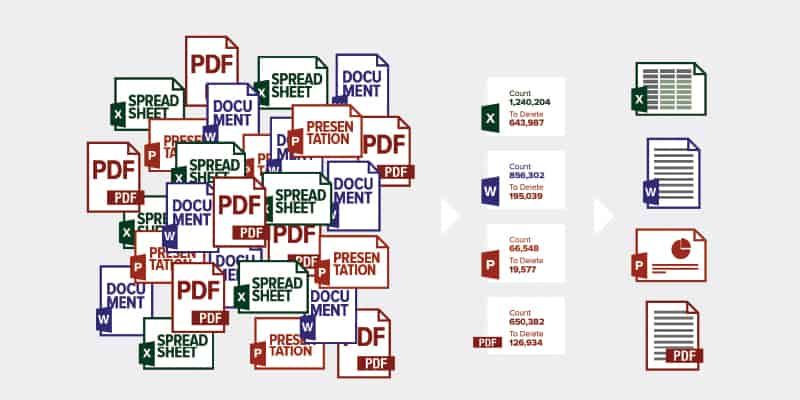While the drive to an all-digital future continues, physical documents are still a fundamental part of most (if not all) housing providers’ processes. How can housing providers ensure that they apply the same rigour to documents as they apply to databases and other electronic storage media, and really leverage the information they contain to enhance the customer experience?
Whether it’s application forms, surveys, certificates or the seemingly unavoidable creation of spreadsheet after spreadsheet, businesses still rely on documents. Colleagues and customers constantly exchange documents and data, with often unknown quantities stored on a maze of drives that are rarely subject to the same rigorous protocols applied to ‘production’ systems.
Document storage is usually the responsibility of the user who has the ability to move documents between different internal drives and even external devices. Documents are downloaded, duplicated and reshared across numerous shared drives, mailboxes and platforms such as SharePoint, with little thought to the risks and costs involved.
Acknowledging the risks
The disparity between the control applied to structured data in databases and documents stored on drives is concerning when considered in the context of GDPR and other regulations, financial risk, and the risk to business process. For example, while we can mandate archiving routines within our own systems to ensure compliance, documents can often persist on home drives, thereby breaching retention policies without a plan for retiring.
Some of the most challenging risks to identify are those where data is making an unknown and unsanctioned journey through document drives. These can be as simple as a headcount spreadsheet in HR containing employee data stored on a drive, or tenant application forms stored in document format feeding into downstream processes. Ensuring these are catalogued and indexed is a key aspect of complying with GDPR processes, such as the right to be forgotten.
Retention policies are notoriously difficult to apply to documents, yet both regulatory and internal policies are often breached by documents containing personal and sensitive data. The complexity is in discovering where these documents are and what policies have been applied to them; the right software tools can greatly accelerate the journey and mitigate the risks.
Counting the cost
Leaving risks aside, the costs to a housing provider of storing the same document multiple times soon escalates in both financial and environmental terms.
Common practices include iterating version numbers of the same document, downloading the same document multiple times or sending a copy of a document to multiple recipients. While solutions such as OneDrive and link-sharing have contributed to reducing this issue, old habits die hard. As with the duplication of data in a database, this practice requires unnecessary storage and the management of significant amounts of (duplicated) data at a cost to the business.
There is an energy and material overhead too. This overhead may seem to be small at a local level, but globally, accounting for the energy used by datacentres, the materials used for storage and the lifespan of drives, there are significant environmental costs because of unnecessary document retention.
Quantifying the problem
To start improving document management, the state of the document space must first be understood. We need to be able to answer questions such as: how many documents do we have; how much space is taken up by duplicate documents; where are my documents stored; and are we retaining information that we should have disposed of?
Here again, the right software can help. The goal is to consolidate all the information that can be retrieved from documents into an accessible and manageable platform. This will allow a business to search for critical information, such as last modified date, document size, document title, author and other metadata.
The second crucial element is being able to search not only the metadata but also the contents of a document. There are a number of methodologies for this; the one we have found to be the most useful is condensing the document content and storing it alongside the metadata. Although this is duplicating the information, a good data management tool can then interact with the information and provide transformational functionality.
Change the future
Consolidating document data into a searchable format is half the journey; the other half is leveraging the technology to change the way documents are managed, understood and, most importantly, used to improve outcomes.
Once indexed, applying data-quality rules to the information retrieved from documents is a powerful capability. Processes that produce the most document issues can be redesigned, and documents that breach policies or regulations can be dealt with by the business.
The highly changeable nature of documents means interacting and monitoring must be as continuous and as automated as possible. This is normally achieved by regular scanning of file servers, mailboxes and other resources, and the application of data-quality rules to identify documents requiring action. It’s important to treat document discovery and management not as a single, one-time project but as an ongoing component of the organisation’s overall data management strategy.
Ideally, document analysis is a two-way street. On the back of the resolution of issues, the business should set and enforce document standards. A tool that automatically issues these instructions increases confidence that document data adheres to policy and allows organisations to demonstrate that data is managed pro-actively across your document and production system space.
By applying tried and trusted technologies, combined with the latest in algorithmic natural language processing, modern document management software can liberate businesses from the burden of manual document maintenance activities, and provide their processes with higher quality, more reliable data to drive the organisation forward.
Stephen Burnett is a senior data consultant at Intozetta.


